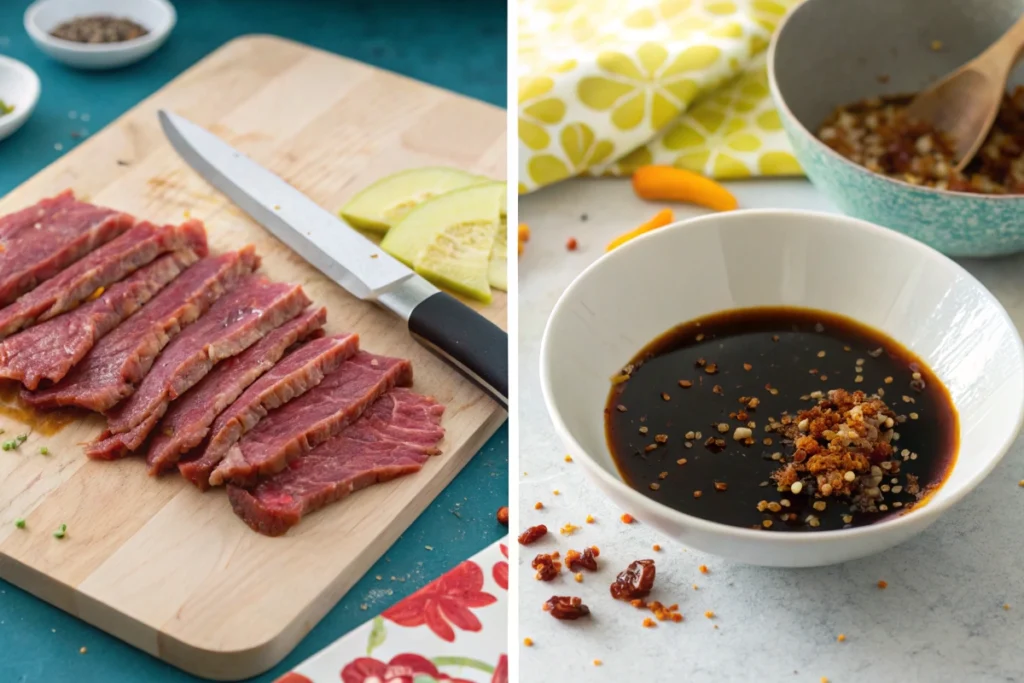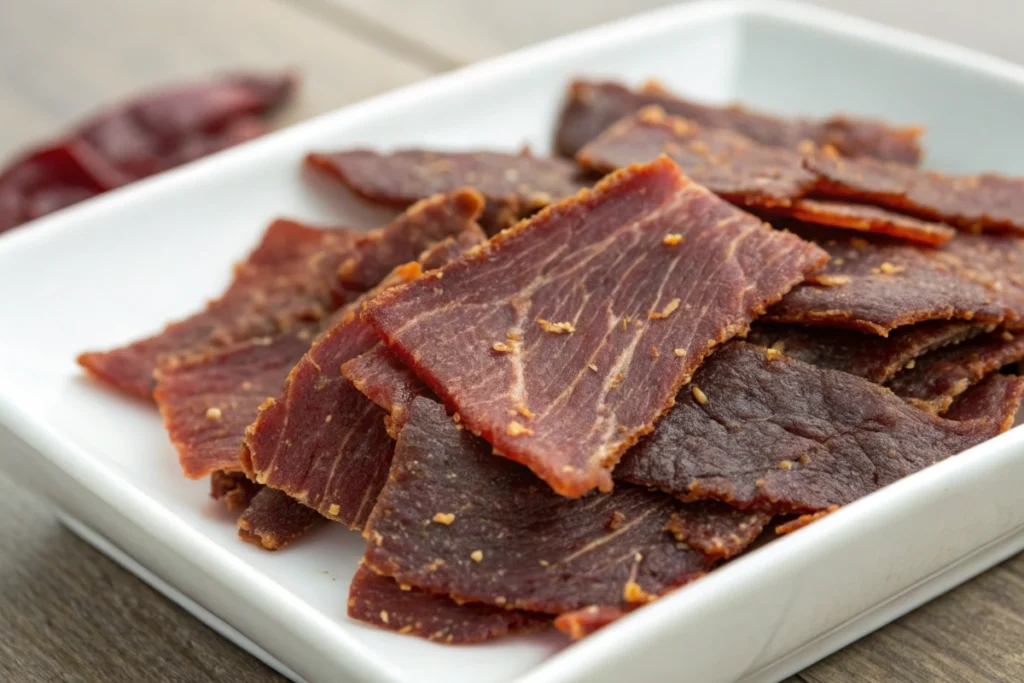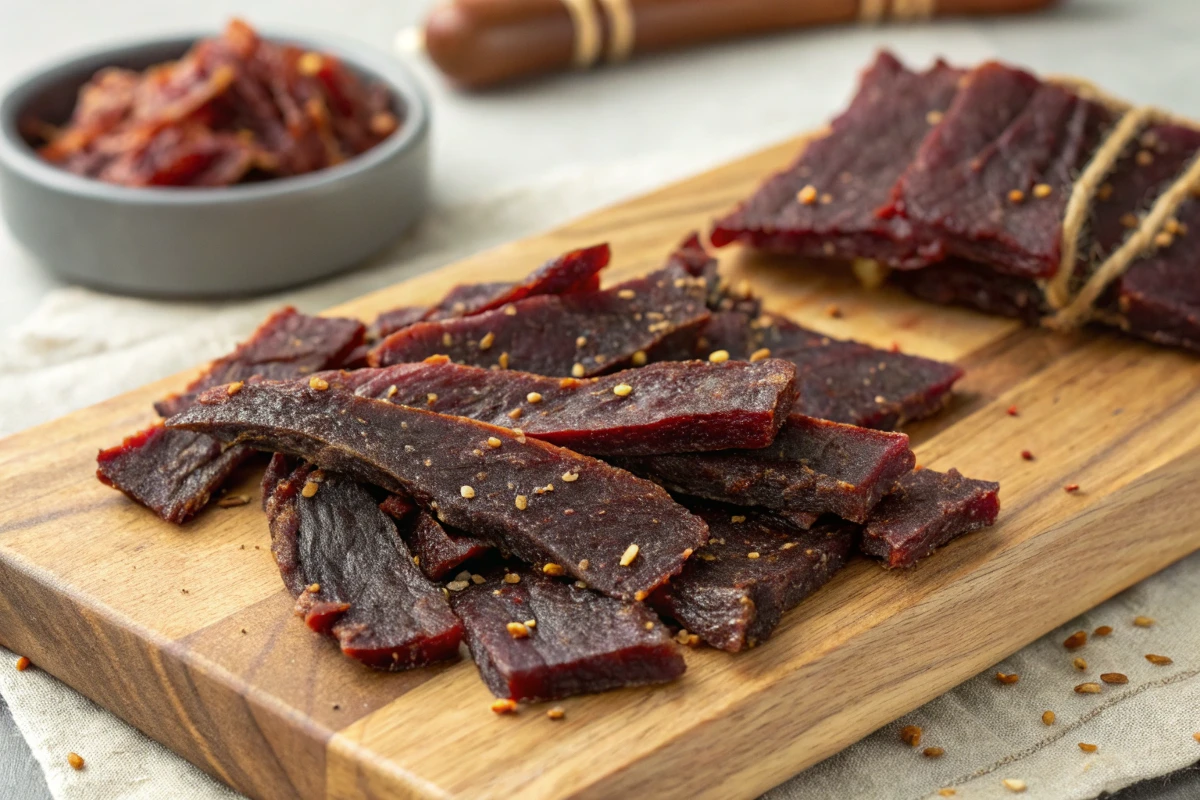Beef jerky has long been a favorite snack for adventurers and food lovers looking for a protein-packed treat. But what happens when classic jerky takes an unexpected turn? Enter sus beef jerky—a quirky concept gaining attention online. Is it just a playful meme, a bold culinary innovation, or something else entirely?
In this article, we explore the fascinating world of this unconventional snack. From its origins to recipes and nutritional insights, you’ll discover everything you need to know about this intriguing take on traditional jerky.
My Love Story with Sus Beef Jerky
I remember the day when I grabbed a pack of Sus Beef Jerky before a long walk. I didn’t think much of it, but once hunger struck, that first bite surprised me! The bold, savory taste gave me the perfect energy boost, and now it’s my go-to snack every time.♥
What is Sus Beef Jerky?
The Origin of the Term “Sus Beef Jerky”
The phrase sus beef jerky gained traction in online culture, combining the abbreviation “sus” (short for suspicious) with the universally loved dried meat snack. Popularized through memes and playful commentary, it’s often used to describe jerky that’s either dubious in quality or unexpectedly innovative in flavor.
Some sources suggest it started as a joke within gaming communities, particularly among fans of the game “Among Us,” where the term “sus” became a viral shorthand for suspicion. However, over time, it’s become a cheeky label for unconventional jerky products.
Understanding the Popularity
Why the buzz around something as specific as sus beef jerky? It’s partly the internet’s love for humor and partly the intrigue of exploring jerky with unconventional or unique flavor profiles. People enjoy the mystery and fun of trying snacks that challenge expectations.
Is It Real or Just a Meme?
While the term may have humorous roots, it doesn’t mean sus beef jerky isn’t real. Many jerky makers have embraced the moniker, crafting products that surprise and delight. Think of bold blends like sriracha maple or smoked pineapple teriyaki—flavors that push boundaries. Even homemade jerky enthusiasts have joined in, experimenting with offbeat spices and techniques to create their own sus-worthy snacks.
The Art of Making Sus Beef Jerky
Crafting sus beef jerky is as much an art as it is a science. From selecting the right cuts of meat to perfecting the seasoning blend, every step plays a role in creating a snack that’s as surprising as it is delicious. Follow this guide to make your own sus beef jerky at home, with a twist that’s bound to spark curiosity.
Essential Ingredients
The foundation of any great jerky starts with quality ingredients. For sus beef jerky, aim for a balance of traditional and unexpected flavors. Here’s what you’ll need:
- Beef: Choose lean cuts like top round or flank steak. These work best because they dry evenly.
- Marinade base: Soy sauce, Worcestershire sauce, and a touch of vinegar.
- Seasonings: Salt, black pepper, garlic powder, and paprika are classics.
- Unique flavors: Add a “sus” twist with pineapple juice, sriracha, or even a pinch of cinnamon.
Step-by-Step Preparation Guide

- Slice the beef: Cut the meat into thin strips, about 1/4 inch thick. Freeze the meat for 30 minutes beforehand to make slicing easier.
- Prepare the marinade: Mix the soy sauce, Worcestershire sauce, and chosen spices in a large bowl. Include any unique ingredients for that signature sus beef jerky flavor.
- Marinate the beef: Place the beef strips in the marinade, ensuring each piece is coated. Cover and refrigerate for at least 12 hours or overnight for maximum flavor.
- Dry the jerky: Arrange the strips on a dehydrator tray or an oven rack. Dry them at 160°F (70°C) for 4-6 hours, flipping halfway through.

Choosing the Right Cuts of Beef
When making this snack, the cut of beef matters. Lean cuts reduce the risk of spoilage while drying. Top round, eye of round, and sirloin tips are ideal because they’re easy to slice and have minimal fat content. Fat can turn rancid during storage, so trim off as much as possible.
Drying vs. Smoking: Which Method Works Best?
Drying beef in a dehydrator or low-temperature oven is the most common method. However, smoking adds an extra layer of flavor that elevates sus beef jerky to another level. If you have access to a smoker, consider using wood chips like hickory or mesquite for a smoky finish that complements bold marinades.
Flavor Profiles and Variations
Sus beef jerky is all about pushing boundaries while maintaining balance. From bold spices to sweet and savory combos, the flavor options are endless. This section explores ways to create jerky that surprises and delights every palate.
Traditional Flavor Variations
Classic jerky flavors remain popular for a reason—they work. For a sus twist, try enhancing these traditional profiles:
- Original: Keep it simple with salt, pepper, and garlic. Add a dash of soy sauce for umami.
- Peppered: Use cracked black pepper liberally, complemented by garlic powder and paprika.
- Teriyaki: Combine soy sauce, brown sugar, and sesame oil for a sweet yet savory kick.
Spicy and Sweet Combos
Spicy and sweet flavors bring depth to jerky, making it more than just a snack. For sus beef jerky, combine unexpected ingredients:
- Honey Chipotle: Mix honey, chipotle powder, and lime juice for a smoky-sweet heat.
- Maple Sriracha: Blend pure maple syrup with sriracha for a bold yet balanced flavor.
- Pineapple Chili: Marinate beef in pineapple juice and add red chili flakes for tropical heat.
Incorporating Unique Ingredients for a Twist
To truly make sus beef jerky stand out, experiment with unusual ingredients:
- Coffee Rub: Add a finely ground coffee rub to create a rich, earthy flavor.
- Cinnamon Spice: A hint of cinnamon paired with cayenne pepper creates a warming sensation.
- Smoked Paprika: This spice delivers a smoky depth that pairs perfectly with sweet marinades.
This snack is all about creativity. By experimenting with new flavors and techniques, you’ll craft a snack that’s as intriguing as it is tasty.
The Nutritional Value
Sus beef jerky isn’t just about bold flavors; it also offers plenty of nutritional benefits. Packed with protein and low in carbs, it’s a go-to snack for fitness enthusiasts, adventurers, and anyone looking for a healthier alternative to processed snacks.
Macronutrient Breakdown
A typical serving of sus beef jerky contains approximately:
- Protein: 10-15 grams, depending on the beef cut and recipe.
- Fats: 1-3 grams, making it a lean snack choice.
- Carbohydrates: Minimal, especially if you skip sugary marinades.
These macronutrients make this snack ideal for low-carb and high-protein diets, such as keto or paleo.
Health Benefits of Beef Jerky
Beyond its nutritional profile, sus beef jerky offers other health benefits:
- High protein content: Supports muscle repair and keeps you feeling full.
- Rich in minerals: Contains iron and zinc, essential for energy and immune function.
- Portability: An easy-to-carry snack for road trips, hikes, or busy workdays.
Is Sus Beef Jerky Suitable for All Diets?
While sus beef jerky is generally healthy, some recipes may not suit specific diets. For example, jerky with high-sugar marinades may not be ideal for diabetics. Similarly, sodium-sensitive individuals should opt for low-salt recipes or use alternatives like coconut aminos instead of soy sauce.
For more delicious protein-packed recipes, check out this guide to savory dishes.
FAQs
What Makes Sus Beef Jerky Different from Regular Jerky?
Sus beef jerky stands out for its creative and often unconventional flavors. Unlike regular jerky, which sticks to traditional recipes, sus beef jerky pushes boundaries with ingredients like coffee rubs, cinnamon, or tropical fruits.
How Long Does Sus Beef Jerky Last?
Properly dried and stored, sus beef jerky can last 1-2 months. For extended shelf life, store it in an airtight container or vacuum-sealed bag and keep it in a cool, dry place.
What Are Common Mistakes in Making Beef Jerky?
Some common pitfalls include:
- Skipping the marinade: Results in bland jerky.
- Cutting uneven slices: Leads to inconsistent drying.
- Using fatty cuts: Can spoil quickly due to rancidity.
By avoiding these mistakes, you’ll craft perfect sus beef jerky every time.
What is the best beef joint for jerky?
The best beef cuts for jerky are lean ones like top round, bottom round, flank steak, or eye of round. These cuts have minimal fat, which helps the jerky last longer and ensures even drying. Trim any remaining fat for the best results in texture and flavor.
What is the white thing in beef jerky?
The white substance on beef jerky is usually a harmless buildup of salt or fat. During the drying process, moisture evaporates, causing salts or fats to crystallize and appear as a white residue. This is completely natural and doesn’t affect the safety or quality of the jerky.
What beef jerky does Frito Lay make?
Frito-Lay produces the Cheetos brand of beef jerky, which combines the iconic Cheetos flavor with high-quality beef. The jerky is available in several flavor options, including original and spicy varieties. This product offers a crunchy, savory snack with a twist on the traditional jerky experience.
How to know when beef jerky is done?
Beef jerky is done when it is firm, dry to the touch, and bends without breaking. If it tears slightly when bent, it’s perfectly dried. Ensure the internal temperature reaches 160°F (71°C) for food safety.
Does beef jerky need to be refrigerated?
Beef jerky does not need refrigeration if it is properly dried and stored in an airtight container. However, refrigeration is recommended for homemade jerky or products with added moisture to extend shelf life and maintain freshness. Always follow storage instructions on packaging for best results.
Is beef jerky gluten free?
Beef jerky can be gluten-free if made with gluten-free seasonings and marinades. However, some store-bought varieties may contain soy sauce or other ingredients with gluten. Always check the label or choose certified gluten-free options for assurance.
For more unique snack ideas, explore this collection of creative recipes.
Conclusion
This snack is more than just a snack; it’s an adventure in flavor, creativity, and nutrition. Whether you’re drawn to its bold and unconventional taste profiles or its convenience as a healthy treat, this unique take on a classic favorite offers something for everyone.
By following the steps in this guide, you can craft your own sus beef jerky at home, experimenting with flavors and techniques to suit your preferences. From traditional marinades to daring new combinations, the possibilities are endless.
If you’re new to making jerky or looking to expand your culinary horizons, don’t hesitate to explore related recipes and techniques to complement your efforts. For more inspiration, check out this hearty meatloaf recipe.
Now it’s time to roll up your sleeves, fire up your dehydrator or smoker, and bring your sus beef jerky ideas to life! Whether you’re snacking on it during a hike or sharing it with friends, this flavorful treat is sure to impress.


I love this article, thanks for sharing!
Thank you! So glad you enjoyed it! 😊 Have you tried the recipe yet?